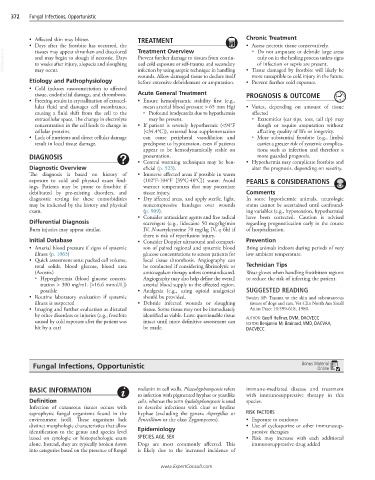Page 785 - Cote clinical veterinary advisor dogs and cats 4th
P. 785
372 Fungal Infections, Opportunistic
• Affected skin may blister. TREATMENT Chronic Treatment
• Days after the frostbite has occurred, the Treatment Overview • Assess necrotic tissue conservatively.
VetBooks.ir and may begin to slough if necrotic. Days Prevent further damage to tissues from contin- early on in the healing process unless signs
tissues may appear shrunken and discolored
○ Do not amputate or debride large areas
ued cold exposure or self-trauma and secondary
to weeks after injury, alopecia and sloughing
of infection or sepsis are present.
may occur.
infection by using aseptic technique in handling
more susceptible to cold injury in the future.
wounds. Allow damaged tissue to declare itself • Tissue damaged by frostbite will likely be
Etiology and Pathophysiology before extensive debridement or amputation. • Prevent further cold exposure.
• Cold induces vasoconstriction to affected
tissue, endothelial damage, and thrombosis. Acute General Treatment PROGNOSIS & OUTCOME
• Freezing results in crystallization of extracel- • Ensure hemodynamic stability first (e.g.,
lular fluid and damages cell membranes, mean arterial blood pressure > 65 mm Hg) • Varies, depending on amount of tissue
causing a fluid shift from the cell to the ○ Profound bradycardia due to hypothermia affected
extracellular space. The change in electrolyte may be present. ○ Extremities (ear tips, toes, tail tip) may
concentration in the cell leads to change in • If patient is severely hypothermic (<94°F slough or require amputation without
cellular proteins. [<34.4°C]), external heat supplementation affecting quality of life or longevity.
• Lack of nutrients and direct cellular damage can cause peripheral vasodilation and ○ More substantial frostbite (e.g., limbs)
result in local tissue damage. predispose to hypotension, even if patients carries a greater risk of systemic complica-
appear to be hemodynamically stable on tions such as infection and therefore a
DIAGNOSIS presentation. more guarded prognosis.
• Central warming techniques may be ben- • Hypothermia may complicate frostbite and
Diagnostic Overview eficial (p. 523). alter the prognosis, depending on severity.
The diagnosis is based on history of • Immerse affected areas if possible in warm
exposure to cold and physical exam find- (102°F-104°F [39°C-40°C]) water. Avoid PEARLS & CONSIDERATIONS
ings. Patients may be prone to frostbite if warmer temperatures that may potentiate
debilitated by pre-existing disorders, and tissue injury. Comments
diagnostic testing for these comorbidities • Dry affected areas, and apply sterile, light, In some hypothermic animals, neurologic
may be indicated by the history and physical noncompressive bandages over wounds status cannot be ascertained until confound-
exam. (p. 909). ing variables (e.g., hypotension, hypothermia)
• Consider antioxidant agents and free radical have been corrected. Caution is advised
Differential Diagnosis scavengers (e.g., lidocaine 50 mcg/kg/min regarding prognostication early in the course
Burn injuries may appear similar. IV, N-acetylcysteine 70 mg/kg IV, q 6h) if of hospitalization.
there is risk of reperfusion injury.
Initial Database • Consider Doppler ultrasound and compari- Prevention
• Arterial blood pressure if signs of systemic son of paired regional and systemic blood Bring animals indoors during periods of very
illness (p. 1065) glucose concentrations to screen patients for low ambient temperature.
• Quick assessment tests: packed cell volume, local tissue thrombosis. Angiography can
total solids, blood glucose, blood urea be conducted if considering fibrinolytic or Technician Tips
(Azostix) anticoagulant therapy unless contraindicated. Wear gloves when handling frostbitten regions
○ Hyperglycemia (blood glucose concen- Angiography may also help define the overall to reduce the risk of infecting the patient.
tration > 300 mg/mL [>16.6 mmol/L]) arterial blood supply to the affected region.
possible • Analgesia (e.g., using opioid analgesics) SUGGESTED READING
• Routine laboratory evaluation if systemic should be provided. Swaim SF: Trauma to the skin and subcutaneous
illness is suspected • Debride infected wounds or sloughing tissues of dogs and cats. Vet Clin North Am Small
• Imaging and further evaluation as dictated tissue. Some tissue may not be immediately Anim Pract 10:599-618, 1980.
by other disorders or injuries (e.g., frostbite identified as viable. Leave questionable tissue AUTHOR: Geoff Heffner, DVM, DACVECC
caused by cold exposure after the patient was intact until more definitive assessment can EDITOR: Benjamin M. Brainard, VMD, DACVAA,
hit by a car) be made. DACVECC
Fungal Infections, Opportunistic Bonus Material
Online
BASIC INFORMATION melanin in cell walls. Phaeohyphomycosis refers immune-mediated disease and treatment
to infection with pigmented hyphae or yeastlike with immunosuppressive therapy in this
Definition cells, whereas the term hyalohyphomycosis is used species.
Infection of cutaneous tissues occurs with to describe infections with clear or hyaline
saprophytic fungal organisms found in the hyphae (excluding the genera Aspergillus or RISK FACTORS
environment (soil). These organisms lack Penicillium or the class Zygomycetes). • Exposure to outdoors
distinct morphologic characteristics that allow Epidemiology • Use of cyclosporine or other immunosup-
identification to the genus and species level pressive therapies
based on cytologic or histopathologic exam SPECIES, AGE, SEX • Risk may increase with each additional
alone. Instead, they are typically broken down Dogs are most commonly affected. This immunosuppressive drug added
into categories based on the presence of fungal is likely due to the increased incidence of
www.ExpertConsult.com

